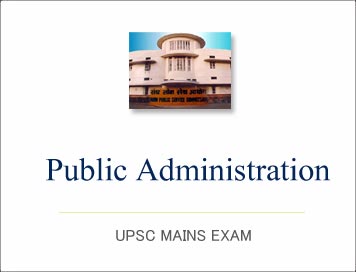UPSC Public Administration IAS Mains 2015 Categorised Paper -2

UPSC Public Administration IAS Mains 2015 Categorised Paper -2
Paper-2
Section-A
Total 250 marks, duration: 3 hours; instructions: Same instructions as Paper-1.
Q1. Attempt all of the following in about 150 words each: 10×5=50
A. “Democracy within bureaucracy is likely to reduce its effectiveness.” Do
you agree with this view? Argue your case. (Philosophical and Constitutional
Framework of Government)
B. “District Collector’s role in the development process has been
overemphasized.” Comment on the statement. (District Administration since
Independence)
C. Why has District Planning been marginalized in many States and remained
prominent in a few States? Explain. (Plans and Priorities)
D. “Ordinance-making power of the Executive needs to be suitably restrained.”
Examine it critically. (Union Government and Administration)
E. ‘Minimum government, maximum governance’ is not just a slogan but a
philosophy of administration with enormous potentialities.” Do you agree? Give
reasons for your answer. (Philosophical and Constitutional Framework of
Government )
Q2. 20 + 20 + 10 Marks
A. To what extent has political culture influenced the administrative culture
of India? Explain. 20 (Philosophical and Constitutional Framework of
Government )
B. Briefly discuss the main recommendations of the Punchhi Commission (2010) on
Centre-State relations for transforming Indian Federal System. 20
(Philosophical and Constitutional Framework of Government )
C. As Dr. B. R. Ambedkar observed, “the text of the Constitution can provide the
organs of the State, but the final outcome of the governance process depends on
how it has operationalized by the political parties and people”. Elucidate the
statement. 10 (Philosophical and Constitutional Framework of Government )
Q3. 20 + 20 + 10 Marks
A. The objectives, approaches and organizational arrangements for
decision-making of the NITI Aayog aim at restoring the federal character of the
Indian polity. Explain. (Plans and Priorities)
B. Explain fully how a balance can be struck between autonomy and accountability
of India’s public enterprises. (Public Sector Undertaking)
C. “Decentralised governance must serve as an instrument of realizing social
change and social justice.” Comment on the statement. (Rural Development)
Q4. 20 + 20 + 10 Marks
A. Discuss the arguments for and against the National Judicial Appointments
Commission Act, 2014. (Union Government and Administration)
B. “In very recent time, the role of the State Governor is found to be more of
diplomatic than administrative nature.” Comment on the statement with suitable
examples. (State Government and Administration)
C. Comment on the recent changes in the approach and methodology of devolution
of responsibilities and transfer of funds from the Union to the States.
(Urban local development)
Section-B
Q5. Attempt all of the following in about 150 words each: 10X5=50
A. Critically examine the concept of community policing as a tool for
improving public-police relations. (Law and Order Administration)
B. Explain how budget can be used as a political instrument. (Financial
Management)
C. “Most Civil Servants in India are competent administrators, but they pay
little attention to encourage people’s participation in decision-making.”
Comment on the statement. (Significant Issues in Indian Administration)
D. Do you think that the functioning of Panchayati Raj Institutions (PRIs), in
practice, reflects genuine devolution of powers and resources? Give reasons for
your answer. (Rural Development)
E. “Information Communication Technology (ICT) improves the quality of public
service delivery, but fails to check bribery.” Comment. (Civil Services)
Q6. 20 + 20 + 10 Marks
A. “Excellent ideas but poor implementation have characterised the
administrative reforms in India since Independence.” Critically examine the
statement giving examples from the Union and State Governments.
(Administrative Reforms since Independence)
B. Do you agree that there has been a serious governance-deficit in development
administration in India? Give reasons for your answer and add your suggestions.
(Political and Constitutional Framework of Government)
C. What are the major concerns of the Second Administrative Reforms Commission
on Civil Service reforms? Indicate the current status of their implementation.
(Administrative Reforms since Independence)
Q7. 20 + 20 + 10 Marks
A. How do the Union Government policies on Smart and AMRUT Cities address the
problems of management of urban development? Explain. (Urban local
development)
B. Discuss the significance and role of the Central Paramilitary Forces in
maintaining law and order and countering insurgency as well as terrorism.
(Law and Order Administration)
C. Discuss the major highlights of the reforms introduced from time-to-time in
Central Civil Services Conduct Rules and add your own comments. (Civil
Services)
Q8. 20 + 20 + 10 Marks
A. “Municipal governance in India is not sufficiently prepared to meet the
challenges of frequent natural disasters.” Elucidate the statement and add your
own suggestions. (Significant Issues in Indian Administration)
B. Discuss critically the salient features of the National Investigation Agency
(NIA) regarding its purposes and jurisdiction. (Law and Order Administration)
C. Argue the case for and against creating Indian Public Enterprises and
Industrial Service for boosting the moribund public sector in India. (Public
Sector Undertakings)
